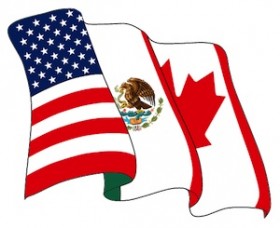 Packing slips, commercial invoices, customs invoices. All are documents that can be easily completed. What I mean is… you are simply taking shipping or invoicing data – shipper, consignee, carrier name, description of goods, etc. and plugging it into the respective area on one of these documents.
Packing slips, commercial invoices, customs invoices. All are documents that can be easily completed. What I mean is… you are simply taking shipping or invoicing data – shipper, consignee, carrier name, description of goods, etc. and plugging it into the respective area on one of these documents.
How about the North American Free Trade Agreement (NAFTA) Certificate of Origin (NCO)? Can you use the same document completion philosophy?
At a quick glance at an NCO, one might assume that the answer is yes. Exporter — yes. Producer — yes. Importer, description of goods, blanket period — yes, yes, yes. Sounds like we”re on a roll! We read the NCO completion instructions, understand what data is required and we”ll just finish this form off to satisfy the foreign purchaser”s request. Right?
Wrong!
The main difference between an NCO and the aforementioned documents is that all the products you list on this document must qualify under the North America Free Trade Agreement. That”s right – do not simply complete the document. There are rules that must be observed.
As we already noted, some fields on the NAFTA Certificate of Origin are fairly basic and you can easily fill them in. The focus of this article is to provide clarification on the less understood areas to raise awareness of their complexity.
Field 6 — Harmonized System (H.S.) Tariff Classification Number
As emphasized in a previous article, it is very important that the H.S. tariff classification is correctly assigned to each product, as the first six digits will determine which of the NAFTA “Specific Rules of Origin” will apply (go to page 141 to see the list). If you are unsure regarding the tariff classification, please contact a customs broker for assistance.
Field 7 — Preference Criterion
The completion of this field is going to depend on where a product was sourced or manufactured, the extent of the manufacturing and transformation process, and/or the source and place of manufacturing for any raw materials. Note that the preference criterion chosen for one product might not be the same as for another, and each situation will need to be evaluated on its own merit.
Field 8 — Producer
Hey, you get a lucky break! This is one of the easier ones. YES, NO(1), NO(2), and NO(3) are your options. The ‘NO’ options of (1), (2), and (3) refer to what you are basing your NAFTA claim on — whether you ‘just know it is NAFTA eligible’ (1), or you have documentation from the producer that it is NAFTA eligible (other than an NCO) (2), or you have a voluntarily provided & accurately completed NCO from the manufacturer (3). We respectfully advise that you go for (3), as this assures that the actual producer has done his due diligence in confirming NAFTA eligibility of the product he is providing to you.
Field 9 — Net Cost
In order to properly complete this field, you will need to understand the NAFTA Specific Rule of Origin applying to a product to determine if Regional Value Content is a factor and whether the Net Cost method will be used. In this field, you will either show ‘NC’ if the Net Cost method was used, or ‘NO’ (all other situations). By the way…do not place a dollar amount in this field, as this merely indicates to a customs agency that you did not read the instructions!
Field 10 — Country of Origin
This one sounds simple, doesn”t it? You would be amazed, however, at the number of NCO”s we receive that indicate countries other than the U.S., Canada or Mexico (remember, it”s the North American Free Trade Agreement). Another common mistake is for someone to automatically assume that just because certain products are made in Canada, the U.S., or Mexico they qualify for NAFTA. In fact, if they do not qualify, they must not be listed on this document.
Sound complicated? In some cases, it is straight forward, but in so many others (for example, products with many foreign components), NAFTA qualification can be an onerous task. The point we are making is for companies and individuals to realize that much care needs to be exercised (before signing, please read the disclaimer at the bottom of the form so you understand your responsibilities).
Repercussions
Your worst nightmare would be a situation where a company has been importing a product for many years assuming that it qualifies under NAFTA (i.e. duty free), then discovering through a customs audit that the goods do not qualify. Regular Canadian or U.S. duty rates range from duty free to over 200%; fines and penalties could also be assessed. Need we say more?
It should be noted that similar rules apply for any Certificate of Origin relating to a free trade agreement. For instance, if you grab a copy of a Canada-Chile FTA Certificate of Origin, you will notice many similarities.
Still baffled over the completion of this document, or whether or not your goods qualify under NAFTA? If you require advice or have questions related to NAFTA, feel free to contact our Trade Compliance Department.
Tags: NAFTA Certificate of Origin







